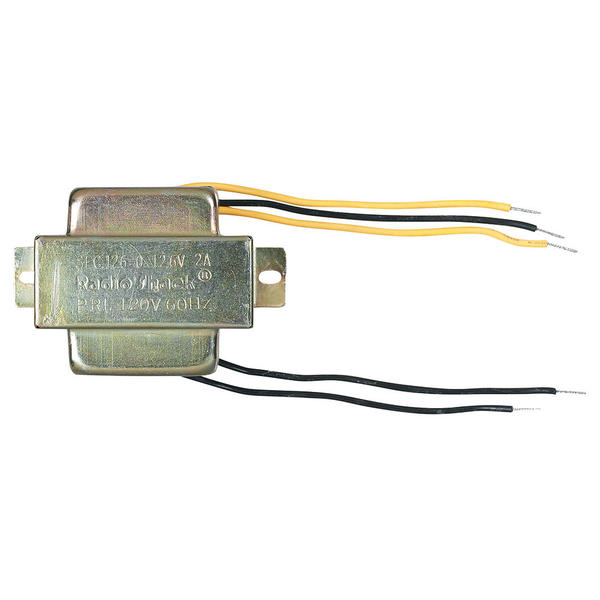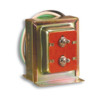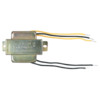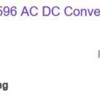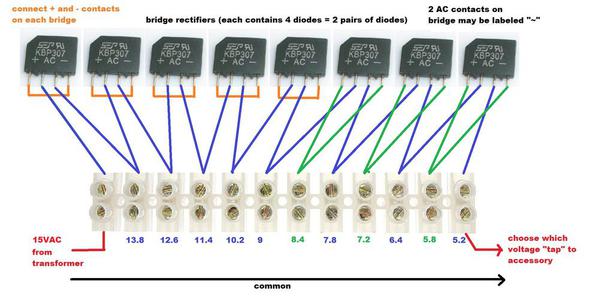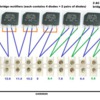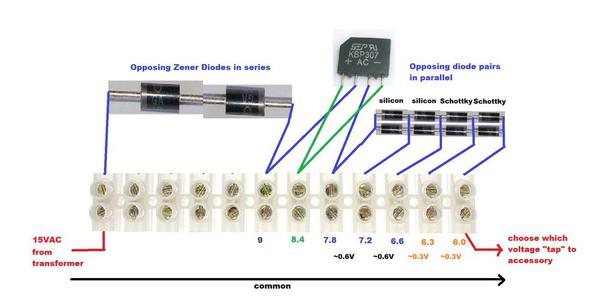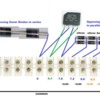I run all my accessories from a transformer operating @ 14-16 volts AC. This work fines for the vast number of accessories. However, occasionally I need to power down the voltage to an single accessory . Case in point, is the Lionel Windmill. I prefer this accessory operating as slow as possible. (which means at a low voltage around 6 volts AC). What is the easiest circuit to construct to reduce the voltage to one accessory, while the rest operate at the higher voltage?
Replies sorted oldest to newest
Desert,
Buy yourself a separate rheostat that will lower your voltage down to whatever you like.
Please let us know how you make out.
Thanks, John
If you understand basic electricity and Ohm's law, the simplest method is to use a resistor in series with the load for which you want a lower voltage. The resistor must have adequate rating to handle the watts (voltage drop x current across and through the resistor). An easy way to do this is with an automotive lamp in series with your load; you can try different sizes of lamps until you find one that gives the desired results. The lamp must be able to handle the same current (amps) as the load.
Or diodes in series as mentioned below - even better.
With something like the windmill, with a very low current draw, you might have a tough time picking a value, and a rheostat like the 81 or 95 won't even slow it down.
This is a good use for a a diode array that has been discussed ad-nauseam on the forum. A well set-up array will allow for a variety of taps to get different combinations of voltage(remember - resistors are for regulating power, usually affecting voltage) for different accessories.
So what is a diode array? How do I make one...and what do I use?
So what is a diode array? How do I make one...and what do I use?
or a lighting dimmer switch- change any out lately?
Most lighting dimmer controls require 120V AC to operate...but the same principle is used in so-called chopped-sine train controllers like the MTH Z-750 which operate at lower AC voltages. So if you have a spare train controller lying around that might be the easiest way to generate a lower AC voltage.
As for the diode string/array method, if you "do" eBay and can wait a few weeks to get parts from Asia, here's a part that should work for your accessory (ebay listing 201322794464). As explained in the links given earlier, each bridge contains 4 diodes. 10 bridges will have enough diodes to drop your AC voltage down to 6V:
Attachments
Thanks Stan...you mention using a 3 amp/ 700volts bridge rectifier...yet the post from JCS Studios calls for a 25 amp / 50 volt rectifier....is that over kill?
Thanks Stan...you mention using a 3 amp/ 700volts bridge rectifier...yet the post from JCS Studios calls for a 25 amp / 50 volt rectifier....is that over kill?
Depends what the load is. I use the 25 amp ones because they are easier to mount,see last pic in link and I use them to drop voltage to the track which can pull as much as 10 amps.
The windmills,I think have an internal 9 volt regulator as I remember from a post a while back. If that is the case here,the diodes will not drop speed until the input is less than the regulator output. . For just the windmills the 3 amp bridges or just a string of paired 1n4001 diodes should be enough.
Another way is to use a buck converter. Reduce the voltage to the desired speed. The windmills should run on DC unless it is the farm windmill with the vibrator motor. that is a different animal.
I show a few uses for the buck converter here. Along with the buck converter, I also use a single diode sting as a DC dropper for the gate shack. There is a pic of it on the link. It may be of some interest.
Dale H
Another way to reduce the 18 volts ac down to 2 VAC is to use a common door bell step down transformer available at Home Depot or Lowes. (This is their 16 vac output model)
Radio Shack also has a step down transformer that will reduce the voltage from 18 vac to about 5 vac. (This is their 25vac output model.)
Lowes transformer with screw output terminals
Radio Shack transformer - 2 yellow wires attach to output (black wire not used)
2 black wires go to 18 vac train transformer
Attachments
Thanks Stan...you mention using a 3 amp/ 700volts bridge rectifier...yet the post from JCS Studios calls for a 25 amp / 50 volt rectifier....is that over kill?
In this application, the current rating (rather than voltage rating) of the diode or bridge drives cost. I don't have your windmill but the consensus seems to be it can be serviced by 1 Amp diodes. Since it appears you have or want to plan for other accessories at possibly other voltages, I figure a 3 Amp component would be suitable. So you could run your windmill at 6V and later use other "taps" off the diode string to get other voltages for other accessories...and still remain well under 3 Amps.
So to answer your question, yes, for this application 25 Amp diodes are not needed. But as Dale points out these were selected for a main track power application where much higher currents prevail. And they do have nice mounting holes. But they are more expensive and would take up much more space. The eBay listing I suggest is quite attractively priced. Ten 3-Amp bridges or 40 diodes for about 3 cents a piece.
I don't know if Dale's comment and link about using a buck converter told you enough but when you say "easiest circuit to construct" that's something to look at. So if indeed your windmill can be powered by DC, then something like this would take just a few wire connections. The module would take 14-16VAC input on one side, and produce regulated 6V DC (or whatever you choose) on the other side.
They're $3 each when you buy 2. Yes, a bit more expensive than the diode approach but ease of construction can't be beat. And you get fully adjustable voltage so you can set it to 5.9V, 6.0V, 6.1V, etc. to exactly tune your windmill RPM. Note that you need to make dozens of connections using the diode array method even if using bridges instead of individual diodes. If you want to pursue this avenue I recall that same thread Dale mentions so someone might remember its name or enough details from it to confirm this is applicable to you.
Attachments
Thanks for the help...the windmill is the vibrating type. The vibration is what makes the motor head turn 360 degrees as the fan blades rotate...(so probably an AC motor and it will not run on DC power) I am only interested in the fan blade rotating vice the motor housing rotating 360 degrees. I will first try the door bell type step down transformers. If that is not effective, then I will try a 1 amp or 3 amp bridge rectifier circuit. I only want to control this one device, so the power/current draw is minimal.
At this point, the only door bell transformer I can find or see listed,(ACE, Home Depot or Lowe's) reduces the AC output voltage to 8 volts. (I might need to reduce the voltage further) I may have to physically go to Radio Shack.
As I reflex, the door bell transformers may not be an option at all....as it requires an input AC voltage of 120 volts....the transformer is supplying 14 volts AC vice this 120.
So, it would appear my best option is the 3amp bridge approach.
As I reflex, the door bell transformers may not be an option at all....as it requires an input AC voltage of 120 volts....the transformer is supplying 14 volts AC vice this 120.
So, it would appear my best option is the 3amp bridge approach.
The input to the door bell transformer would be about 18 vac not 120 vac. The transformer reduces the output in proportion to the input.
You will have to excuse me, I am not all that familiar with electronics/electrical stuff. The door bell transformer from Lowe's list and input voltage of 120 volts...You are saving this does not matter and the transformer will reduce the voltage regardless and proportional to the input AC voltage? So, it will operate with an input AC input voltage of 14 volts? and is rated for up to 120 volts input.
Thanks for the help...the windmill is the vibrating type. The vibration is what makes the motor head turn 360 degrees as the fan blades rotate...(so probably an AC motor and it will not run on DC power) I am only interested in the fan blade rotating vice the motor housing rotating 360 degrees. I will first try the door bell type step down transformers. If that is not effective, then I will try a 1 amp or 3 amp bridge rectifier circuit. I only want to control this one device, so the power/current draw is minimal.
Try a single diode first. Sometimes vibrator motors work well on half waved pulsed DC. It is actually more unbalanced than AC current. You can buy a package of diodes at Radio Shack for about $2, or in quantity on Ebay for about 2 cents each. The transformer will give too much reduction,10 to 1 if it is 12 volt and is not adjustable. The diodes are adjustable in .6 volt increments. keeping with AC, 10 paired diodes will reduce voltage by about 6.5. The single diode will effectively cut voltage in half. The buck converter will not work for your application.
Dale H
I've used the buck converter with a diode out in front of it for my K Line (Lionel) turbines.Fiddle with the adjusting screw and tune them to the speed you want. Easy and they are cheap on Ebay.
Roger
...You are saving this does not matter and the transformer will reduce the voltage regardless and proportional to the input AC voltage? So, it will operate with an input AC input voltage of 14 volts?
Correct. For the matter at hand, it's the ratio of input to output voltage. So if a transformer hooked to 120VAC input delivers 12VAC output or a 10:1 ratio, it will output 1.4VAC when hooked to your 14VAC accessory voltage. So you go hunting around Radio Shack or wherever and notice common transformers are 24VAC/25.2VAC or maybe 48VAC. You do the math and decide for yourself if you can make the numbers work for you. If your train transformer accessory output voltage has adjustability from 14 to 16VAC (or whatever) then you get a little wiggle room. Or if the output is a bit high after the transformer you can use pairs of nickel diodes to drop the AC voltage in ~0.6V increments.
...You are saving this does not matter and the transformer will reduce the voltage regardless and proportional to the input AC voltage? So, it will operate with an input AC input voltage of 14 volts?
Correct. For the matter at hand, it's the ratio of input to output voltage. So if a transformer hooked to 120VAC input delivers 12VAC output or a 10:1 ratio, it will output 1.4VAC when hooked to your 14VAC accessory voltage. So you go hunting around Radio Shack or wherever and notice common transformers are 24VAC/25.2VAC or maybe 48VAC. You do the math and decide for yourself if you can make the numbers work for you. If your train transformer accessory output voltage has adjustability from 14 to 16VAC (or whatever) then you get a little wiggle room. Or if the output is a bit high after the transformer you can use pairs of nickel diodes to drop the AC voltage in ~0.6V increments.
And, If you make a mistake and hook it up backwards, you will have 140 volts coming out. If you are real lucky and you find the right transformer,you may get an acceptable voltage,it would be trial and error.
here is 100 diodes 1 amp, for $4.
Here is a terminal strip,buy a couple at $2.70 each
On second thought,this terminal strip would work better,it is a bit smaller at $2.25 each.
Take 22 diodes. Pair the leads in opposite direction and twist the leads together. You will then have 11 pairs.
Bend the leads U shaped and insert into the strip on one side in series. (close the screws on the other side so the leads don't come through.)
When you are done you will have an adjustable AC voltage dropper capable of dropping about 7 volts. With AC current each of the paired diodes will carry half the load so you have about 2 amp capacity. The windmill most likely will use about a half amp or less so the diodes are adequate.
Put the string in series with one of the leads to the windmill. The more diodes in series ,the slower it will run.
If you need even more drop you can continue with more diodes on the second barrier strip.
Again a single diode by itself will effectively cut the voltage in half also. If it is not too slow it will work. If it is still too fast additional single diodes in series will reduce voltage further.
I put my windmill on a repeat cycle timer so it turns on and off. With additional timers and a diode string you could vary the speed of the windmill and turn it on and off. In real life it is not consistently windy,nor does the wind blow at a constant speed,though modern windmills have governors. Old farm windmills may have had weights as governors.
Speaking of windmills I live by the modern ones. I just picked up another hawk,the third this weeks than met it's doom with the blades.
I dont remember if the accessory has a small DC motor or a vibrator. If it is a small DC motor,the buck converter will work.
Dale H
That could be said for many things. If you screw up connecting stuff, it's not uncommon to see the magic smoke escape! ![]()
I don't routinely thing of adding a transformer, but the risk of connecting it wrong is a bit overstated I believe.
On operating your windmill @ 6 VDC I would first measure the actual voltage that you feel is good for the operation of the windmill, then measure current at the voltage. The use ohms law to find the resistance needed (dividing the current into the voltage). I would use a wire wound resistor about 5 to 10 watts. AS Ace stated.
There are a lot of ways to do this, just look for the simple/safest way or just pick up a small 6 V DC wall type power supply or a small HO DC power supply.
If you do end up using the diode array approach, I see some low-cost 12-position terminal strips on eBay for less than $1 with free-shipping (ebay 381365796499):
When dropping a lot of voltage such as from 15VAC accessory voltage down to 6V in this case, that's quite a lot of diode pairs. That is, at about 0.6V drop per pair, the 9V total drop requires 15 pairs or 30 diodes. That's a lot of diode leads to deal with! If using terminal strips as an interconnection method, that's quite a long terminal strip too.
So I patched together the following which is just an idea. This does not provide any more information than what Dale describes in his links on diode dropping - this is simply some thinking out loud specific to the windmill application.
So the task is to drop from 15VAC accessory voltage to around 6VAC. A bridge with its 2 diode pairs drops about 1.2V when shorting the + and - contacts. Since the area of interest is down near 6VAC, the upper voltage drops are not of interest so these do not need to be accessible on the terminal strip. When the voltage drop reaches the area of interest, then the +/- contacts on the bridge can be joined at the terminal strip. I don't have the components in hand and the picture is not to scale but perhaps one could feed two leads from the bridge devices into a screw-terminal position and possibly not need additional wire. The +/- connections on the higher voltage bridges could be simply twisted together without going to the screw-terminal. Again, just an idea...
Attachments
Wow...thanks for all the help Dale and Stan....you have helped me to find a solution and in the process learn a bit more about electronics.
I will construct the bridge rectifier / barrier strip circuit ...take a picture and report back. I hope it is half as neat as the above picture. If you find yourself in the desert...let me know....I owe you big time
That could be said for many things. If you screw up connecting stuff, it's not uncommon to see the magic smoke escape! ![]()
I don't routinely thing of adding a transformer, but the risk of connecting it wrong is a bit overstated I believe.
Years ago, I connected a transformer correctly one time (primary/secondary connections were correct anyway), but with a MUCH higher primary voltage (only 4 times higher) than it was supposed to have. Results were quite impressive on start up, both smoke and some other stuff (looked like fire balls) came from the 24vac devices connected to the secondary. Happened instantly, as power was applied. ![]()
It would not be adjustable, but if you are sure of the diode voltage drop you want, a pair of zener diodes in a series opposed connection is the way to go. To use the numbers discussed in this thread, a pair of 1N5339BG will give a drop of about 6.3 in either direction (5.6 zener voltage + .7 forward drop of the forward biased diode) , and will handle a current of around 850 mA.
52 cents each in small quantities, and only 3 connections to make! But, it leaves no room for experimentation.
Over the course of my working career, I've released the magic smoke a number of times, stuff happens. ![]()
Good learning experiences, the kind you don't forget. That was the worst one for me, but over the years there were a few other minor incidents here and there. ![]()
By trying to keep up with all the posts here I am hoping to avoid train related smoke releases (other than from the smoke stack). Sure is a lot of good information passed around here from all you guys that know this stuff so well.
It would not be adjustable, but if you are sure of the diode voltage drop you want, a pair of zener diodes in a series opposed connection is the way to go.
This is an excellent suggestion illustrating a variant of the diode dropping method. Stated differently there are different types of diodes with different voltage dropping characteristics. The use of a bridge-rectifier instead of pairs of loose diodes amounts to a packaging or form-factor variation...the voltage dropping performance is the same. Let's see if this stirs up the pot:
So using PLCProf's example, two 5.6V Zener diodes would drop about 6.3V. So in the example drawn earlier, this could replace 5 bridge-rectifiers since each bridge drops about 1.2V. The selection of Zener diode size is generally one of Power capability (in Watts) rather than current capability (in Amps) as for loose diodes or bridge devices. I couldn't find a broad selection of zener diodes suitable for this application on eBay so if buying just a few 50 cent diodes from US mail-order (Mouser, DigiKey) you will pay more for shipping than the parts.
But speaking of diode alternatives, I modified the picture to also show the "loose" diode method and to illustrate yet another diode type. To get more dropping resolution than ~0.6V from the most common Silicon type, you can use Schottky diodes which have about half the drop of about ~0.3V.
The point of the modified picture is showing that you can mix/match devices to create a customized set of taps to generate multiple voltages. This kind of reminds me of transformers with multiple outputs or "taps" off the secondary winding.
Attachments
It's good to keep in mind that the Zener diodes dropping larger voltages will also dissipate more power. The rating will be more important as the Zeners will be dropping a lot more power than the individual diodes.







